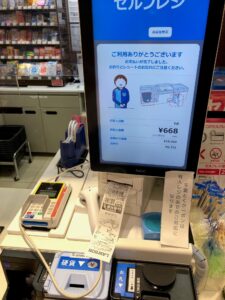I visited Japan in June as a visiting researcher, at the Tokyo Department of International Digital and Design Management, School of Management, Tokyo University of Science (TUS). TUS is located in the middle of Tokyo next to the Kanda River. The university was founded in 1881 and is one of Japan’s oldest private universities in science and technology. I visited the Department of International Digital and Design Management, (IDM), which provides an exciting education for combining design, knowledge of digital technology, and the ability to interact with different cultures.
During my stay in Tokyo, I collected data for two research streams: to evaluate the accessibility of self-service technologies in Japan, and to explore cross-cultural differences in self-service technologies in Japan and Finland. Based on observational research, I randomly selected self-service terminals and took photographs and videos from self-service technologies namely self-service terminals, self-ordering kiosks, self-checkouts, vending machines, ticket vending machines, automatic teller machines, self-service laundries, and self-service lockers. I collected data that contained photographs and videos of 33 different self-service technologies and their user interfaces.
The state of accessibility of self-service technologies in Japan
 The number of users of digital services is constantly increasing, as more and more services are becoming available only in digital form. Covid-19 pandemic accelerated digital transformation and nowadays people interact with digital services using self-service technologies almost everywhere in our daily lives. Digital interaction has become a new norm of our society and the target is to have all public services for citizens as well as businesses digitally available. Therefore, digital services need to be accessible so that all citizens have equal opportunities to participate in society.
The number of users of digital services is constantly increasing, as more and more services are becoming available only in digital form. Covid-19 pandemic accelerated digital transformation and nowadays people interact with digital services using self-service technologies almost everywhere in our daily lives. Digital interaction has become a new norm of our society and the target is to have all public services for citizens as well as businesses digitally available. Therefore, digital services need to be accessible so that all citizens have equal opportunities to participate in society.
– Accessibility refers to the “extent to which products, systems, services, environments, and facilities can be used by people from a population with the widest range of user needs, characteristics, and capabilities to achieve identified goals in identified contexts of use”. Accessible and culturally adaptive IT artifacts such as websites, mobile applications, and self-service technologies can increase the individual’s autonomy in using services and overall satisfaction.
Prior studies offer important knowledge that enables practitioners to enhance the accessibility of self-service technologies from one angle at once. However, the overall picture of possible issues of accessibility of these technologies is fragmented. Moreover, the current state of accessibility is vague. There is first a need to categorize possible accessibility issues that the use of self-service technologies may consist of, and secondly, explain how these issues are related to each other, and what are the fundamentals of these issues. This study aims to gain in-depth rich data to describe the reality of accessibility of digital services.
Exploring cross-cultural differences in self-service technologies in Japan and Finland
 Rapid digital transformation and adoption of new digital technology for products, services, and operations emerge with accessibility issues. When digital products or services are published internationally or are targeted for citizens with cross-cultural backgrounds, it is crucial to keep in mind the variety of cultural backgrounds of the users. Nations, namely, Japan and Finland have similarities in their guidelines in legislation on the accessibility of digital services. Regarding technology adoption, Japan provides an interesting viewpoint for research as fundamental interaction patterns have some differences compared to Finland. Therefore, cross-cultural research between Japan and Finland can gain an in-depth understanding of interaction patterns and how these should be considered in user experience design for cross-cultural contexts. The knowledge of different cultural backgrounds can develop the user experience of products overall.
Rapid digital transformation and adoption of new digital technology for products, services, and operations emerge with accessibility issues. When digital products or services are published internationally or are targeted for citizens with cross-cultural backgrounds, it is crucial to keep in mind the variety of cultural backgrounds of the users. Nations, namely, Japan and Finland have similarities in their guidelines in legislation on the accessibility of digital services. Regarding technology adoption, Japan provides an interesting viewpoint for research as fundamental interaction patterns have some differences compared to Finland. Therefore, cross-cultural research between Japan and Finland can gain an in-depth understanding of interaction patterns and how these should be considered in user experience design for cross-cultural contexts. The knowledge of different cultural backgrounds can develop the user experience of products overall.
The benefits of approaches such as user-centered design to IT artifact design have been identified and recognized essential for capturing users’ needs related to human factors and contexts. However, factors affecting user experience in different cultures may also conflict. Yet the understanding of the cross-cultural factors affecting products’ accessibility and usability remains vague. The realization of accessibility still requires design patterns that emphasize the broadest range of users’ abilities, actual needs, and the context of use. This study aims to contribute to the theories of Human-Computer Interaction that integrate cross-cultural factors.
The studies will continue with Japanese and Finnish partners. The visit was funded by The Scandinavia-Japan Sasakawa Foundation.
Please see the Department of International Digital and Design Management, School of Management, Tokyo University of Science: https://www.tus.ac.jp/idm/index-en.html?utm_source=main_visual_en
 Author Juho-Pekka Mäkipää, PhD is a university lecturer of information systems at the University of Vaasa, School of Technology and Innovations. Juho-Pekka’s research focuses on the development of digital accessibility in the areas of theories, methodology, design, ethics, and management. At the University of Vaasa, he also teaches courses on accessibility, human-computer interaction, and user experience.
Author Juho-Pekka Mäkipää, PhD is a university lecturer of information systems at the University of Vaasa, School of Technology and Innovations. Juho-Pekka’s research focuses on the development of digital accessibility in the areas of theories, methodology, design, ethics, and management. At the University of Vaasa, he also teaches courses on accessibility, human-computer interaction, and user experience.




